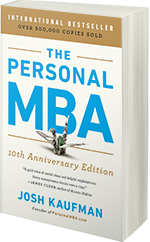Master the Art of Business
A world-class business education in a single volume. Learn the universal principles behind every successful business, then use these ideas to make more money, get more done, and have more fun in your life and work.
What Are 'Barriers to Purchase'?
Selling anything is largely the process of identifying and eliminating Barriers to Purchase: anything that prevents your prospect from buying what you offer.
These are the five standard objections in every sales process:
- Loss Aversion: It costs too much. Makes spending feel like a loss.
- It won't work.
- It won't work for me.
- I can wait.
- It's too difficult.
It's smart to structure your offer with those objections in mind:
Objection #1 is best addressed via Framing and Value-Based Selling. If it's clear that the value of your offer exceeds the asking price, the objection is moot.
Objections #2 and #3 are best addressed via Social Proof. Show the prospects how others like them are benefiting from the offer. That's why Referrals are such a powerful tool.
Objections #4 and #5 are best addressed via Education-Based Selling. If the customer doesn't realize they have a problem, they won't be looking for a solution. Focus your early efforts in making them smarter and then helping them Visualize what would happen if they proceed.
Once you have their Attention and Permission, there are two possible tactics if they still have objections:
- Convince them that the objection isn't true.
- Convince them that the objection is irrelevant.
Always try to negotiate with the decision-maker.
Josh Kaufman Explains 'Barriers to Purchase'
Assume for a moment you present an offer to a prospect, and their reply is something along the lines of, "No-that doesn't work for me." Time to pack it in and move on?
There's always a reason a prospect says no. The fact that they're even talking with you implies that there's at least some interest-otherwise, the conversation would simply end. There's still hope of closing the sale, if you start asking the right questions.
Selling anything is largely the process of identifying and eliminating Barriers to Purchase: risks, unknowns, and concerns that prevent your prospects from buying what you offer. Your primary job as a salesperson is to identify and eliminate barriers standing in the way of completing the Transaction. Eliminate the your prospect's objections and barriers, and you'll close the deal.
There are five standard objections that appear in sales of all kinds:
- It costs too much. Loss Aversion makes spending money feel like a loss - by purchasing, the prospect is giving something up, and that naturally makes people hesitate. (Some people even experience this sense of loss after they make a purchase decision, a condition called "buyer's remorse.")
- It won't work. If the prospect thinks that there's a chance the offer won't (or can't) provide the promised benefits, they won't purchase.
- It won't work for ME. The prospect may believe that the offer is capable of providing benefits to other people, but they're different - a special case.
- I can wait. The prospect may believe they don't have a problem worth addressing right now, even if it's very clear to you that they do.
- It's too difficult. If the offer takes any effort whatsoever on their part, the prospect may believe that their contribution will be too hard to manage.
To overcome these objections as quickly as possible, it makes sense to build them into the structure of your initial offer. Since these objections are very common, anything that you can do to alleviate them before the prospect considers the offer will be make the sales process much easier.
Objection #1 ("it costs too much") is best addressed via Framing and Value-Based Selling. If you're selling a piece of software to a business that can save them $10 million dollars a year, and you're asking $1 million a year for a license, your software isn't expensive - it's effectively Free. If it's clear that the value of your offer far exceeds the asking price, this objection is moot.
Objections #2 and #3 ("it won't work" / "won't work for me") are best addressed via Social Proof - showing the prospect how customers just like them are already benefitting from your offer. The more like your prospect your stories and testimonials are, the better. That's why Referrals are such a powerful sales tool - customers tend to refer people who have similar situations and needs, and the Referral itself helps break down these objections.
Objections #4 and #5 ("I can wait" / "it's too difficult") are best addressed via Education-Based Selling. It's not uncommon for prospects not to realize they have a problem, particularly in the case of Absence Blindness. If the business doesn't realize it's losing $10 million in the first place, it's difficult to convince them that you can help. The best way to get around this is to focus your early sales efforts on making your customers smarter by teaching them what you know about their business, then helping them Visualize what their involvement would look like if they decide to proceed.
Once you have the prospect's Attention and Permission, there are two possible tactics if they still have these objections: (1) convince the prospect that the objection isn't true, or (2) convince the prospect that the objection is irrelevant.
The approach you'll use depends on the objection raised, but some combination of Framing, Value-Based Selling, Education-Based Selling, Social Proof, and Visualization will usually do the trick.
If the prospect still doesn't buy, that typically means there's a Guiding Structure issue-your negotiating partner may not have the budget or the authority to agree to your proposal.
Always try to negotiate directly with the decision-maker-that way, if they refuse your offer, you know that it's because it wasn't a good fit for them, and you can move on to more promising prospects as quickly as possible.
Questions About 'Barriers to Purchase'
- What objections might your prospects have to your offer?
- What barriers are preventing them from saying ‘yes'?
- How can you alleviate their objections and remove as many barriers as possible?
"Selling begins when the prospect says 'no.'"
Sales Maxim
Sales
https://personalmba.com/barriers-to-purchase/
Master the Art of Business
A world-class business education in a single volume. Learn the universal principles behind every successful business, then use these ideas to make more money, get more done, and have more fun in your life and work.

